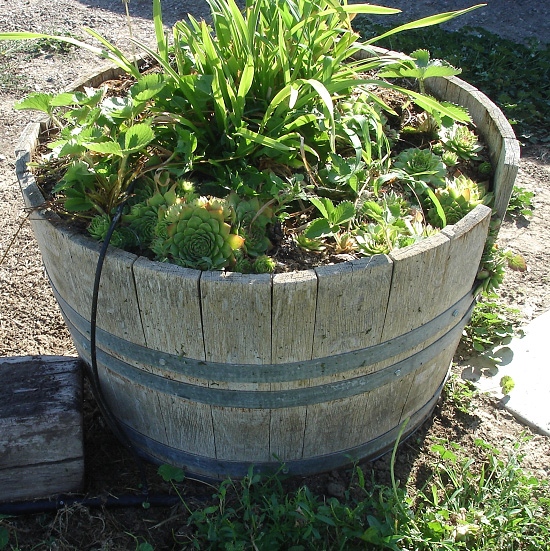Scope
Use micro-irrigation for water-efficient landscaping.
- Select the appropriate equipment for the task. Micro-irrigation technologies include bubbler, drip, trickle, mist, or spray and subsurface water emitters.
- Install micro-irrigation systems that are equipped with pressure regulators, filters, and flush end assemblies.
See the Compliance Tab for links to related codes and standards and voluntary federal energy-efficiency program requirements.
Description
Micro-irrigation is an important feature in a water-efficient landscape but requires additional components to ensure the system operates efficiently.

The term "micro-irrigation" describes a family of irrigation systems that apply water through small devices and at lower pressure than sprinkler irrigation systems. These devices deliver water onto the soil surface very near the plant or below the soil surface directly into the plant root zone. Compared to sprinkler irrigation systems, the conveyance loss is minimal and evaporation, runoff, and deep percolation are reduced. Because micro-irrigation operates at a lower pressure, a pressure regulator is required. Filters are required because emission devices are easily clogged by debris. Flush end assemblies flush the laterals after the end of an irrigation cycle.
Micro-irrigations systems rely on the frequent application of small quantities of water on or below the soil surface. Water may be delivered as drops, tiny streams, or miniature spray through emitters or applicators placed along a water delivery line. Micro-irrigation encompasses a number of methods or concepts, such as bubbler, drip, trickle, mist, or spray and subsurface irrigation. For purposes of this specification, micro-irrigation includes emission devices that have flow rates less than 30 gallons per hour (113.6 liters per hour).
Certified irrigation professionals should be experienced in the design and installation of micro-irrigation, as it takes expertise in this area to ensure an efficient system. Micro-irrigation should be installed on separate zones from the rest of the irrigation system if sprinkler heads are used in other parts of the landscape. Builders should work with a certified irrigation professional to ensure a pressure regulator, proper filters, and flush end assemblies are installed.
If using drip irrigation, EPA WaterSense recommends using pressure-compensating drip. These products help deliver a constant flow rate over a range of pressures and are intended for landscapes with wide fluctuations in elevation, topography, and pressures.
Success
The EPA WaterSense Home Specification does not have mandatory outdoor requirements. However, if installed, these systems may contribute to the mandatory 30% efficiency requirement. Refer to the specific WaterSense Approved Certification Method (WACM) for specific requirements.
If installed, it is recommended that a certified irrigation professional verifies that any micro-irrigation systems comply with the criteria in the WACM.
In addition, the certified irrigation professional will verify that the station or zone pressure based upon the emission device or product being used (drip emitter, rotor head) is within +/- 10 percent of the manufacturer-recommended operating pressure. The certified irrigation professional will test this on a representative zone of the micro-irrigation system.
Climate
Minimize irrigation needs by designing climate-appropriate landscaping and selecting native and drought-tolerant plant species. Schedule watering to match local climate conditions. For example, irrigation watering is not typically needed in most U.S. climates in the fall, winter, and spring.
Compliance
Retrofit
The measures described in this guide applies to the design of irrigation systems for both new and existing homes.
More
More Info.
Access to some references may require purchase from the publisher. While we continually update our database, links may have changed since posting. Please contact our webmaster if you find broken links.
The following authors and organizations contributed to the content in this Guide.
Sales
Efficient Landscape Irrigation =
EPA’s WaterSense program certifies weather-based irrigation controllers, which employ a "smart" irrigation control technology. These systems use local weather data to determine when and how much to water. Drip irrigation systems use 20% to 50% less water than conventional pop-up sprinkler systems and can save up to 30,000 gallons per year by delivering low volumes of water directly to the plant's' roots, minimizing losses to wind, runoff, evaporation, or overspray. Other technologies for reducing water use include control technologies that measure the moisture in the soil and tailor the irrigation schedule accordingly, rain sensors and rainfall shut-off devices that turn off irrigation on rainy days, and rotary spray sprinkler heads that lose less water to evaporation than misters.
